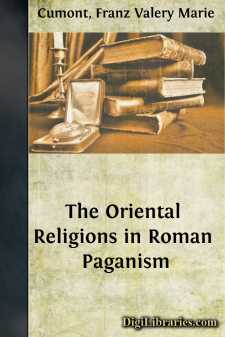Categories
- Antiques & Collectibles 13
- Architecture 36
- Art 48
- Bibles 22
- Biography & Autobiography 813
- Body, Mind & Spirit 142
- Business & Economics 28
- Children's Books 17
- Children's Fiction 14
- Computers 4
- Cooking 94
- Crafts & Hobbies 4
- Drama 346
- Education 46
- Family & Relationships 57
- Fiction 11829
- Games 19
- Gardening 17
- Health & Fitness 34
- History 1377
- House & Home 1
- Humor 147
- Juvenile Fiction 1873
- Juvenile Nonfiction 202
- Language Arts & Disciplines 88
- Law 16
- Literary Collections 686
- Literary Criticism 179
- Mathematics 13
- Medical 41
- Music 40
- Nature 179
- Non-Classifiable 1768
- Performing Arts 7
- Periodicals 1453
- Philosophy 64
- Photography 2
- Poetry 896
- Political Science 203
- Psychology 42
- Reference 154
- Religion 513
- Science 126
- Self-Help 84
- Social Science 81
- Sports & Recreation 34
- Study Aids 3
- Technology & Engineering 59
- Transportation 23
- Travel 463
- True Crime 29
The Oriental Religions in Roman Paganism
Description:
Excerpt
INTRODUCTION.
THE SIGNIFICANCE OF FRANZ CUMONT'S WORK.
Franz Cumont, born January 3, 1868, and educated at Ghent, Bonn, Berlin, and Paris, resides in Brussels, and has been Professor in the University of Ghent since 1892. His monumental work, Textes et monuments figurés relatifs aux mystères de Mithra, published in 1896 and 1899 in two volumes, was followed in 1902 by the separate publication, under the title Les Mystères de Mithra, of the second half of Vol. I, the Conclusions in which he interpreted the great mass of evidence contained in the remainder of the work. The year following, this book appeared in the translation of Thomas J. McCormack as The Mysteries of Mithra, published by the Open Court Publishing Company. M. Cumont's other work of prime interest to students of the ancient faiths, Les religions orientales dans le paganisme romain, appeared in 1906, was revised and issued in a second edition in 1909, and is now presented in English in the following pages.
M. Cumont is an ideal contributor to knowledge in his chosen field. As an investigator, he combines in one person Teutonic thoroughness and Gallic intuition. As a writer, his virtues are no less pronounced. Recognition of his mastery of an enormous array of detailed learning followed immediately on the publication of Textes et monuments, and the present series of essays, besides a numerous series of articles and monographs, makes manifest the same painstaking and thorough scholarship; but he is something more than the mere savant who has at command a vast and difficult body of knowledge. He is also the literary architect who builds up his material into well-ordered and graceful structure.
Above all, M. Cumont is an interpreter. In The Mysteries of Mithra he put into circulation, so to speak, the coin of the ideas he had minted in the patient and careful study of Textes et Monuments; and in the studies of The Oriental Religions he is giving to the wider public the interpretation of the larger and more comprehensive body of knowledge of which his acquaintance with the religion of Mithra is only a part, and against which as a background it stands. What his book The Mysteries of Mithra is to his special knowledge of Mithraism, The Oriental Religions is to his knowledge of the whole field. He is thus an example of the highest type of scholar—the exhaustive searcher after evidence, and the sympathetic interpreter who mediates between his subject and the lay intellectual life of his time.
And yet, admirable as is M. Cumont's presentation in The Mysteries of Mithra and The Oriental Religions, nothing is a greater mistake than to suppose that his popularizations are facile reading. The few specialists in ancient religions may indeed sail smoothly in the current of his thought; but the very nature of a subject which ramifies so extensively and so intricately into the whole of ancient life, concerning itself with practically all the manifestations of ancient civilization—philosophy, religion, astrology, magic, mythology, literature, art, war, commerce, government—will of necessity afford some obstacle to readers unfamiliar with the study of religion....


